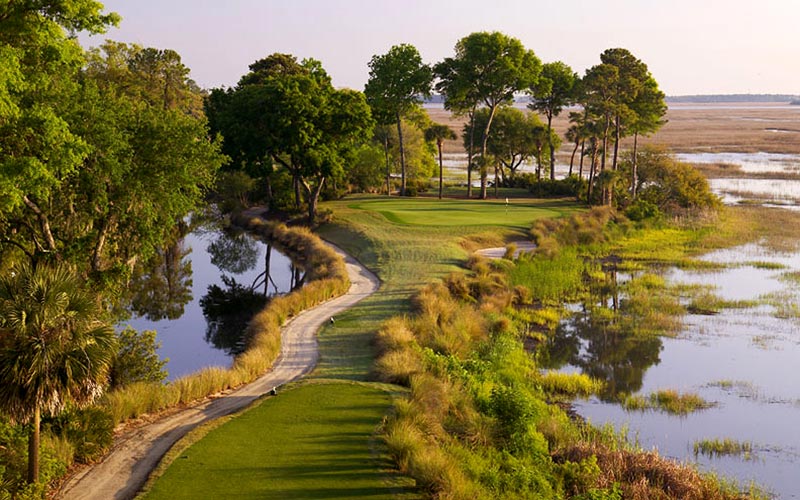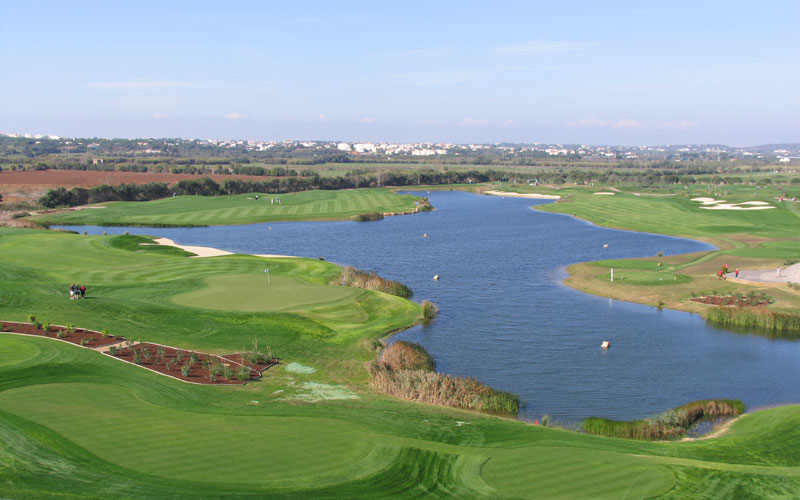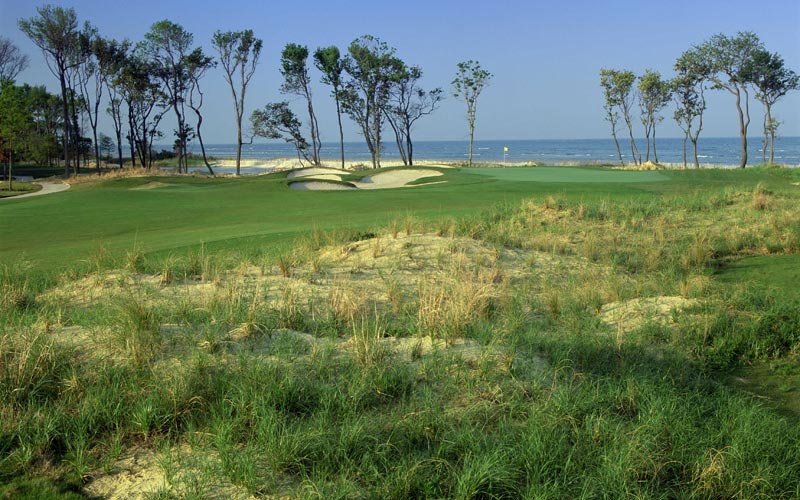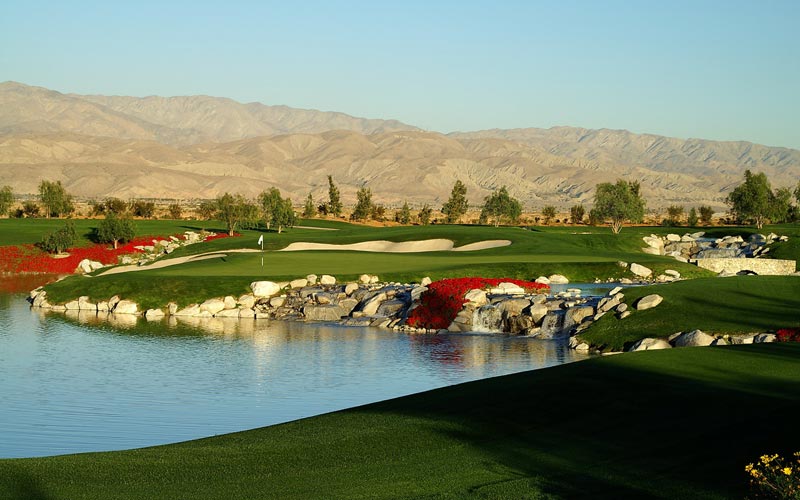Feature Interview with Vicki Martz
July, 2009
1. How did you get into this male dominated field?
When our family moved to Jacksonville, Fl. In 1979, I had youngsters in school but wanted to work part time in landscape design as I had recently majored in Landscape Architecture at UK. Although I had to leave the program early due to my husband’s job transfer I knew this was my profession for life. Little did I realize that my career path would slightly shift when I went to work for Mark McCumber, touring pro and owner of a landscape design firm. This was Mark’s first foray into golf architecture and I learned as his company grew. Eventually I was offered a drafting position with Ed Seay and Arnold Palmer and continued to learn under their tutelage. They gave me the opportunity to grow within the company and always were gender blind with our work. I am proud and lucky to say that I have now been with Arnold Palmer Design Co. for over 24 years.
2. Your title with Arnold Palmer Golf Design is VP and Director of Environmental Design, what does that entail?
Ed and Arnold presented me with the title of Vice President when I was accepted into the ASGCA in 2000. It was a significant milestone in my career and acknowledged that I had worked at that time on over 50 courses doing everything from cut/fills, take-offs, bid documents and ultimately my own designs. As Vice President I oversee projects from the initial prospect calls through full design and completion of bid documents and then direct the project through construction into grow-in. As the Director of Environmental Design, I keep tabs on all of our projects that have site-sensitive issues and assist when needed in the permit process. This became my passion by the late 80’s and early 90’s when regulatory agencies were getting more directly involved in projects. I have worked with several coastal agencies walking projects on the Gulf of Mexico, the Chesapeake and coastal marshes along the Atlantic through the challenging permit process and more recently have worked in depth with several California counties. Each situation is different and working with the various agencies is both interesting and frustrating. I have worked with Bill Love who heads up our Environmental committee for the ASGCA and we are working closely with the EPA in Washington to streamline the process. ASGCA members are strong advocates of eco-sensitive design so it has been mostly a task of communicating and demonstrating that fact to the various agencies.
3. How did you get interested in the environmental aspect of golf design?
Around 1990 I had the fortunate opportunity to work closely with Ed Seay on the design and construction review of Old Tabby, a private golf course on Spring Island near Beaufort, SC. Spring Island is an uncommonly beautiful sea island of 3,000 acres whose natural landscape includes marshes, creeks and a dense forest of giant historic live oak trees. Developers Chaffin and Light asked us to design a course that would fit naturally and sensitively into that pristine environment. From that experience I learned that great design could be unobtrusive and that preserving and enhancing the natural features of the land gives a course character, identity and unique challenge. Old Tabby and Spring Island have won numerous environmental awards as well as significant awards for design. I am a firm believer that one does not exclude the other and that award winning design can be environmentally responsible.
4. What is the most interesting development in environmental preservation since your career began?
Aside from the challenge of working on Spring Island, a number of other projects come to mind that were each quite unique in environmental sensitivity but I was drawn to a special site on the Big Island of Hawaii. In the early 90’s Mr. Palmer was asked to design a second course for the Mauna Kea Resort. The Hapuna Golf Course is, as the name suggests, a mountainous course and has many beautiful rock outcroppings and drought tolerant native plants including buffel grass, flowering ilima and Kiawe trees. Working with Erik Larsen of APDC we conserved this existing landscape as natural buffers between the holes and routed the golf course to disturb only 75 acres of land. The conservation of water was further enhanced by designing separate ponds for use of effluent thus significantly reducing the need for ground water. Once the ponds and reservoirs had filled at the end of construction a tabulation of the bird sightings revealed the populations had doubled with the newly created habitat. That was a joy to experience and see before we had left the project.
5. Why does Old Tabby work so well as a residential golf course?
When Old Tabby was designed, corridor widths had not changed for years. Most architects were still using the “typical†of 300 ft wide corridors at the angle turn. At Old Tabby, we wanted the golfer to have a “core golf†experience and, in addition wanted to insulate the holes with as much of the wonderful native tree cover that we could. Our minimum width for angle turns was 400 feet at Old Tabby which was quite unique at that time. Conservation, protection and preservation were the ultimate goals of the owners, Jim and Betsy Chaffin and Jim Light. That forward -thinking philosophy was my first encounter with an owner that would shrink the housing component for the overall enjoyment of the experience. What a difference it has made for both the golfer and the residences. In addition, there is minimal “target golf†but lots of options for strategic play. Two of the holes provide alternate fairways for totally different set-ups. We were very cognizant that the course would need to accommodate all ages and caliber of players. With many options for getting to the green I think it keeps the course interesting while a challenge.

The 17th at Old Tabby Links
6. Did you enjoy particular freedom there vs. some of your other projects?
If you know Betsy Chaffin you know that she values artistic freedom and integrity. With that in mind, we were brought into the project early enough that we collaborated on the total land plan which is so important in making all of the elements work cohesively together. Too often the golf architect is the last person brought into a planned project and I personally think the project can suffer when that happens. Finding the natural green and tee sites keeps costs down and maximizes the overall experience. We were given great freedom and latitude with our only caveat to save “as many trees as we possibly couldâ€. When I first saw the site after our trip over on boat from the mainland, I was convinced that God lived there. I have never seen any piece of land more beautiful and natural and knew our biggest challenge would be not to mess it up! It was a fun and rewarding experience.
7. What stereotypes do you fight as a woman architect?
I can be very soft-spoken and have made great friends with many of the crews I have worked with over the years. I came to realize very early on however, that my mild manner gave the impression I could be manipulated easily as we reviewed projects in the field. Our method has always been to climb in the back of a pick-up and drive the centerlines, getting down every few hundred yards to do closer review of angles to the green, etc. When I first went alone, I was ushered down the hole at a good clip in the hopes that I would nod my head and keep going. That is when I realized that unlike my male counterparts I would need more than ever to demonstrate my knowledge and my ability to make decisions. After a few projects, they didn’t navigate me quite so quickly. Other than that I must say that I have enjoyed working in the field and love the collaboration process.
8. Describe a hole that you have designed and why it plays so well for a five, fifteen and twenty-five handicap player.
That is what good golf design is all about. It is relatively easy to design a very difficult hole and certainly just as easy to design a hole that everyone plays well. The trick, of course, is to design a hole that offers challenge and strategy for golfers of all abilities while keeping it fun. I like a hole that offers you those choices right when you set up on the tee. There are a number of good par 5’s that offer the opportunity for the better player to get home in two and yet bail-out options around the impending hazard for the higher handicap player to still save par. However, I also value the par 4 that can incorporate that same sense of drama and danger, yet playable for everyone. Hole seven at the TPC of the Twin Cities is one example of this. It is only 327 yards from the tips and so enticing for the pros to drive the green over water and a large beach bunker. Be evading that option and playing it as a dogleg, a strong complex of bunkers guards the green. The straighter the tee shot the less trouble entering the green. It is a pretty hole and offers good reward for which ever risk the player chooses. I think everyone enjoys it.

The seventh at TPC Twin Cities
9. How have you evolved as an architect over your 25 year career?
Years ago, I read as much as I could and I learned from my mentors, Ed Seay and, of course, Arnold Palmer who taught me so much as to the playability of a hole. He certainly brings his knowledge of how a tour player would navigate the course but his constant concern for the average player and the choices they are presented keeps me on my toes. Arnold and Ed never wanted a “cookie cutter†look and so each of the architects in our office was given artistic license. I learned much from following senior Palmer architects, Erik Larsen and Harrison Minchew, around the country absorbing their unique style. As I developed as an architect I realized how important it was to see the work of other architects, not only as many of the classics that I could but taking the opportunity to visit other contemporary work by my peers. This has been invaluable to me. The more courses I see and play the more “out of the box†my thinking becomes.
10. Is there an example of a hole/feature that you have recently built that you wouldn’t have earlier in your career?
Yes, I think that #16 at Oceanico Victoria at first glance appears to be a simple hole, rather short and not too much trouble. When you play it you realize that the placement of the tee shot and the second shot is really important in saving par. The green has subtle yet definite contouring that can feed the ball away from the hole and into collection areas. If you don’t approach the green from the right angle for that pin you can find trouble getting up and down. This subtle yet defining strategy is something I wish I had introduced earlier into my designs. Working with the PGA tour actually made me realize the importance of each pin location and the contours the player would need to navigate. Just a few tenths of an inch in slope can make a marked difference in how the player attacks the green. I think I am more cognizant of “Sunday Pins†and what is the quality of the hazard that protects them.

Host of the 2005 World Cup, Oceanico Victoria in the Algarve.
11. Your course Oceanico Victoria is host of the Portuguese Masters tournament – do you take a much different approach when designing tournament courses?
The real difference in designing for tournament play today is narrowing the target landing area for tour players with hazards pushed to 300 yards and beyond. At the end of the day, however, these courses host players of all abilities and they need to have enough challenge and strategic design to bring them back without demoralizing them. As a fairly typical female golfer I know how intimidating long forced carries can be and I always keep that player in mind when offering alternative routes to the greens. It’s all about choices within a round. Any time you can get the professional player questioning his decision of club or best route to the green the course can usually defend par.
12. The world is a tough place right now and golf needs to be fun and relaxing or it will continue to loss players. Describe a course that you have built and its features that invigorate players to come back for a round time and time again.
A few years ago I had the wonderful opportunity to work with a developer who had his heart and soul into a very historical piece of land that fronted the Chesapeake Bay and its marshes. Dick Foster had been an engineer on the Chesapeake Bay Bridge Tunnel as a young man and came to love the Eastern shore of Virginia. He asked us to design the first course at Bay Creek, (near the town of Cape Charles) which wound through the marshes and along the Bay itself. I enjoyed immensely land planning that beautiful piece of land with Dick and creating holes that incorporated direct links to the Chesapeake. There were obviously a number of environmental restrictions and challenges but the effort was worth it. We encouraged Dick to bring in Audubon International to insure the protection of habitat throughout the site and to demonstrate his pro-active commitment.
The natural setting along the Chesapeake provides much of the risk/reward element of the course. A dune system winds itself through the course and although it is often a hazard, a player can find his ball and continue play. It has generous fairways, subtle greens and at least five sets of tees on each hole. It is certainly a challenge for the low handicap but is most fair for all other caliber of players. As a higher handicapper, I love it. As my boss, Ed Seay used to say…â€keep a course beautiful and playable and most of all make it fun!†I think Ed was right. There is nothing a golfer enjoys more than standing on the tee, taking in the beauty of the hole and the impending challenge and then playing it well. Look hard and play easy! That will bring them back.
Today, Bay Creek has added a second course, which we had incorporated into the initial landplan. An interesting side note was that a competing architect and I were to meet with Dick for our initial planning meeting. I had prepared a full land plan on the chance he would want to review something. Upon arriving Dick said “I hope you brought me something other than a Christmas cardâ€. Luckily by that preparation I was given the opportunity to do the first course. You don’t come across that many God given sites. This one is very special.

The natural setting at Bay Creek’s setting, complete with the Chesapeake in the background.
13. How do you and Arnold Palmer interact on designs?
I have had the pleasure of working for Mr. Palmer for nearly 25 years. He has allowed me to grow to my potential and is always anxious to hear my thoughts on design of a certain hole. While he can read the plans he prefers to visit our work when the hole has been roughed in. He is always asking questions and intuitively knows when a hole isn’t working or is too difficult for the average player. He has certain design criteria, but is always willing to listen if you have a reasonable argument. I had designed a long par 4 at Twin Cities that curved around a lake and with the green on the water. The tee was elevated and the entire hole could be seen from the tee so the golfer had the option of challenging the water as much as he wanted from the tee. The green sat right down on the water with one pot bunker in the face between the green and the water. Mr. Palmer normally doesn’t like to weaken the difficulty of the shot by putting distance or a saving bunker between the green and the water. When I explained it was a great aiming tool from the tee and would not be an easy bunker shot he reflected on it and then relented. We all enjoy our collaborations with him.
14. Is there an area that stimulates the most debate between the two of you?
14. Yes, I must say that his desire to keep greens directly on the water when water is in play can be challenging. There are some courses that due to the high water table, such as courses in Florida, numerous holes have water associated with them. I want to keep the relationship of green to water that he likes but it can be difficult to differentiate the look around the course. Recently, at the Classic Club, in Palm Desert, we were presented with unusual storm water elevations due to drainage from the mountains. To assure the green would not flood it meant that a par three would need to be placed unusually high above the normal water elevation. Putting the green directly on the water and knowing he would not like a staging of bunkers in the face to take up the slope left me concerned with the design. I asked him to assist me in creating a solution. He loved the challenge and now it is known as “Arnold’s holeâ€. His solution was a cascading waterfall that would bend to the front of the green. It is a gorgeous hole and we all loved his total involvement.

“Arnold’s Hole”, the twelfth at the Classic Club.
15. Arnold Palmer grew up shaping shots both ways. Unfortunately, golf now is more of a power sport with players blasting away indiscriminately. How do you keep finesse as a required element in successfully playing one of your courses? What are some examples?
I think that good design always incorporates options for play and therefore decisions from the tee. Some examples from courses that I have done include a split fairway (#14) at Oceanico Victoria. There is a small narrow fairway with an easy access to the green but demands a 240 yard carry from the back tee. The alternate fairway left is actually divided by a lone central bunker giving players two options of playing. Keeping the play right of the bunker along a cascading stream leaves a mid iron to an elevated green on the water. By playing left of the central bunker most players will choose to lay up and use a wedge for their play to that tricky green site.
At Mountain View Country Club in La Quinta, CA, the 18th hole is a 550 yard par 5 to an island green. The best angle of play is to play straight from the tee to a narrow lower fairway with can feed the ball to the water’s edge. A short iron over the water and beach bunker can possibly get the player to the green in two. The safer, longer route is to play to the wider elevated fairway right and then a second shot short of the water for a pitch to the green. There is an opportunity, if the drive is long enough and the player elects the safer fairway, that the ball will find a “speed slot†carrying the ball far enough to safely reach the green in two but with at least a mid iron.
These are a couple of examples that illustrate that scoring for the better player is not always about power but making intelligent choices in course management. Finesse is a great word for this aspect of the game.

Vicki, Jim Chaffin, Ed Seay and Mrs and Mr. Palmer on site at Spring Island
16. How did you and Ed Seay interact?
I cannot say enough about Ed Seay and his influence on my career and really my life. He was my boss, my mentor and my friend. He came across as one tough Marine but I’ve never know someone who had as much compassion as Ed. He would take me out and tell me to just watch the dozer operators in action. One day when he thought I was ready, he had me give directions to the crew for what I wanted done with a green complex. After I had explained what I wanted he had me sit down for as long as it took to complete and watch so that the next time I gave an order to an operator I would understand the complexity and the time it would take. He rarely stood over you to critique your work but would ask you what you thought of it. If you couldn’t explain it you realized, without him saying, that you didn’t have a grasp on the hole or the design. He gave you a key and said that there were no hours. You knew what you had to do and it was up to you to get it done. His way with people was extraordinary. I can’t tell you how many nights and weekends we all worked because he had given us ownership of our time. Sly devil….he knew we would work harder. Our profession lost a great architect and a great humanitarian when Ed finally got tired of being sick.
17. What were Seay’s greatest attributes as an architect?
Ed Seay was generous in his life and in his career. Ed believed that a course needed to have beauty either in the site itself or though the design. He also believed that everyone should have a good time on a course, not just a select few that play the game very well. He designed generous landing areas, did not believe in hazards that would only impact the weak players and preferred softly contoured greens. He had the eye of an artist and the shape of mounding behind a green would take as much time as bunker complexes. My favorite story when working with Ed had to do with Old Tabby. He took the shapers out to a beach along the marsh and asked them to look at the lines in the sand the waves and wind had made. “This is what I wantâ€, he said. He loved the detail and was an incredible teacher in that respect. His design of Sawgrass C.C. in the early 70’s, before his association with Arnold, was highly regarded and won the course top 100 distinction for many years. When the PGA Tour came to Ponte Vedra Beach they wanted to incorporate the name of Sawgrass due to its recognition and popularity.

Ed and Arnold.
18. What are your thoughts on Tralee?
I was fortunate to have the opportunity to play Tralee after having worked in Ireland. It was an incredible experience and was my first exposure to links golf. I take great pride in parring two of the par threes….one on the water and the other over a deep ravine. I think it stands right up there with many of the classic links courses of Ireland. I do remember one hole that had you aim out over the water so that the wind would draw the ball back into the fairway. The wind and weather is so much a part of the game in that environment. Ed did a great job in incorporating that into the rhythm of the course.
19. How do you cultivate fresh design ideas (through travel aboard, through seeing other architect’s work here in the United States, etc.)?
Absolutely. I have had great opportunities in my travel for work to see courses in a variety of locations. I try not to critique but to absorb. Later this year I am travelling with several associates from the ASGCA to Australia where we are joining with the EIGCA and the Australian Society of Architects to tour and play some of the great McKenzie golf courses. I think we are a unique group. As professionals and competitors we continue to learn and, more importantly, share design concepts and ideas with each other. The ASGCA recently played Chamber’s Bay, the newly selected site for the 2015 US Open. It was an incredible experience and we loved hearing the stories about how the course came to be. In the States, I often take an extra day when travelling to visit a course I have heard about. It gets the creative juices flowing and keeps me on my toes.
20. Your current work is in the Indian Ocean, what are the pros and cons of working so far from home?
That is a tough one. Obviously, the issue of time to travel such a long distance keeps you in a jet-lag fog for a day or so. Luckily, there are a handful of golf courses already on Mauritius and so finding quality people with such experience is not too bad. However, I find that clients outside of the U.S. can be less informed about the total process of getting a course from paper and into the ground. We often have to be “teachers†to them and their staff. The pros certainly outweigh the negatives, however, and working within another culture is always fun and challenging. We all want to make the very best course in that unique environment and realize that people from all over the world will come to play and some to first learn the game. Keeping it fun, playable and beautiful will hopefully get them hooked.
The End


